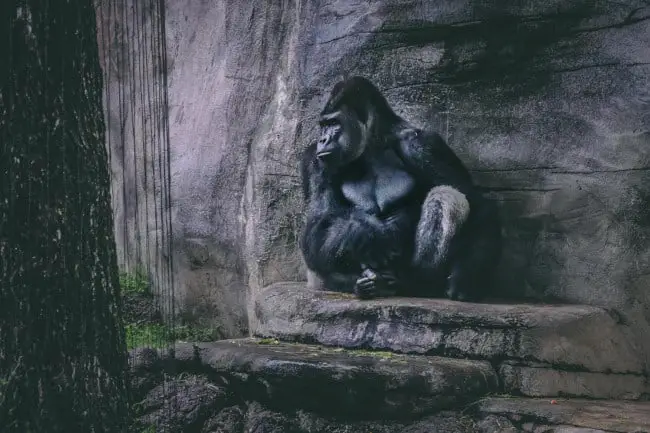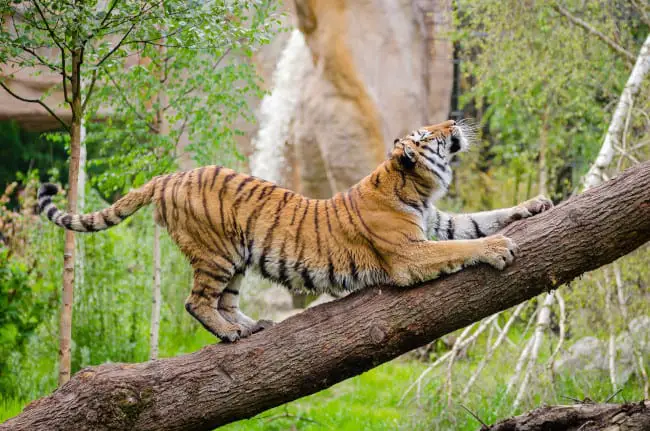The environmental enrichment concept is known for some decades now. It has been around at least since the early part of the 20th century when Robert Yerkes (1925) wrote: “The greatest possibility for improvement in our provision for captive primates lies with the invention and installation of apparatus which can be used for play or work.”
Nowadays it is known as a basic animal husbandry principle that seeks to enhance the quality of captive animals care. This principle goes along with many names these days: Animal enrichment and behavioural husbandry as an example. One of my favourite definition of environmental enrichment and in my opinion best explaining is this: “The provision of stimuli which promote the expression of species-appropriate behavioural and mental activities in an understimulating environment (Viktor and Annie Reinhardt, 1998).” And in this explanation lies also the downfall of environmental enrichment at how it’s applied by many people. But first, why is it important?
Why is environmental enrichment important?
An animal in the wild is constantly stimulated and surrounded by sounds, smell, tastes and challenges of the natural surrounding. When we remove an animal from its natural surrounding we automatic remove the sources of these stimulations. Removing the chase of a lion from an antelope will not be that harmful, the removal of the need to forage and be in a social group will be very detrimental. Without the proper physical and mental stimulation of species-appropriate behaviour has harmful consequences like overweight and inactivity of an animal and development of abnormal behaviour, resulting in many health issues that will come along. So it is important to stimulate all captive animals to perform their species-appropriate behaviour. It will increase behavioural diversity, reduce the frequencies of abnormal behaviour, increase positive utilization of the environment and increase the ability to cope with (tougher) challenges in a more normal way. Environmental enrichment is a tool to accomplish these stimulations. That sounds easy, you probably will say. But why, after all these years, is it still not common practice to use environmental enrichment for captive animals?

The pitfalls of environmental enrichment
When we take a look at the definition from earlier, it can be divided into three cornerstones. As a caregiver, you have to apply (1) stimuli to increase the (2) species-appropriate behaviour in an (3) understimulating environment. However, environmental enrichment is a tool to improve and not a remedy to cure all mental and physical challenges for an animal. Enrichment is not a substitute for poor enclosure design, lack of healthcare or any other poor management activities. For example, enclosure design for captivity is as important to increase the correct stimulation for the animals. Think of a tiger in an enclosure without elevation and climbing structures. If you give this animal a different puzzle feeder every day doesn’t make it physically healthier. Another example, it is not mentally stimulating enough to give a social animal multiple mirrors to interact with daily. While it is an important aspect of positive animal welfare, alone it can’t compensate for sub-standard care that results in poor welfare. But environmental enrichment plays an important part in the stimulation of a broad spectrum of natural behaviours. Another pitfall to keep in mind is this: we tend to enrich the animals we care for only in the ten to twelve hours we work at a facility. Animals live in their captive environment 24/7, so we have to stimulate the correct behaviours also in this timeframe. Ever thought about what an animal do at night? In some facilities, we close animals in their inside enclosure for the night without any form of mental and/or physical stimulation. Keep this 24/7 welfare concept in mind when designing an environmental enrichment program.
How does environmental enrichment help?
Environmental enrichment (programs) help within three main areas, what can be called as the three C’s: Choice, Change, Create. It creates choices for animals so they can have more control over their environment. Change and variety are important to prevent frustration and boredom. At last, it will create opportunities to increase the complexity of their environment in a way that is meaningful to the animal.
But how to use environmental enrichment then?
First of all, set goals on what you want to achieve. It is important to plan what enrichment to implement and evaluate if your enrichment effort achieves your goals. For this, take a look at the S.P.I.D.E.R. framework. I’m convinced about the following principles for environmental enrichment:
- No more free lunches: increase the foraging time of every meal;
- Stretch, balancing, jumping, climbing, pulling: keep your animals fit with enough physical stimulation. Contrafreeloading, the concept that animals prefer the food that requires effort, is scientifically proven by many animals;
- Physical effort increase the health on the long-term;
- Ask for the challenge, not for the impossible: Keep in mind what the normal species behaviour is.
- There is more than food and puzzles: Use all kinds of stimulating enrichment like smell and sound.
- Keep in mind what you want to achieve.

Stress, abnormal behaviour and stereotypic behaviour
When enriching animals doesn’t mean that all stimulation has to be positive. When an animal experiences short-term stress is not harmful, and with a physical and mental healthy animal it can cope well with more stressful situations. When you provide dung from a predator as enrichment can cause some level of stress, but it is not harmful. As an example, when we hang vulture feather in the meerkat enclosure will trigger an alarm-call from the animal(s) and they will hide mostly together (sometimes for half a day). Is it bad? When you do that daily and cause long-term stress, or even chronic stress, will have health implications. Also behaviourally there will be changes. When an animal can’t cope with its normal behaviour, often abnormal behaviour develops. Abnormal behaviour can be described as ‘behaviour patterns or sequences of behaviour that differ fundamentally from the behaviour of free-living animals’. Mostly it is derived from the normal behaviour patterns. When the state of the animal is not improving, stereotypic behaviour can develop. These repetitive, invariant behaviour patterns have no obvious goal or function. Development of stereotypic behaviour is generally most prevalent in conditions believed to be aversive to animals, like physical confinement, lack of critical resources, lack of stimulation, social isolation, fear and frustration. These conditions can easily be stimulated with environmental enrichment, so keep that in mind. It has been shown in many cases that increasing the complexity of their environment and the addition of enrichment can severely reduce and even stop the stereotypic behaviours completely.
Further reading
- Wild Enrichment (website)
- The Shape Of Enrichment (website)
- The Disney’s Animals, Science and Environment Animal Enrichment Program (website)
- Second Nature, Environmental Enrichment for Captive Animals – David J. Shepherdson, Jill D. Mellen, and Michael Hutchins (book)
- Environmental Enrichment for Captive Animals – Robert J. Young (book)
Share this page!